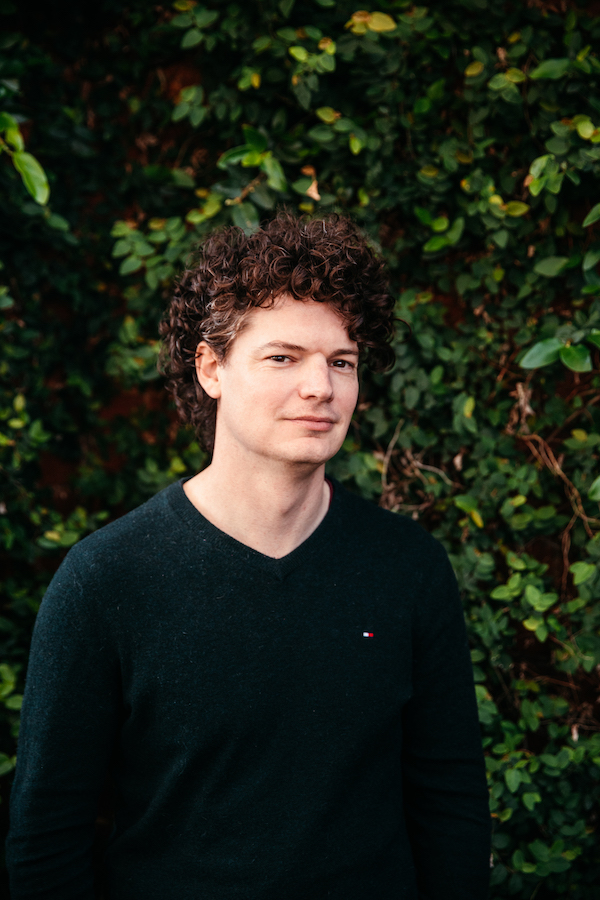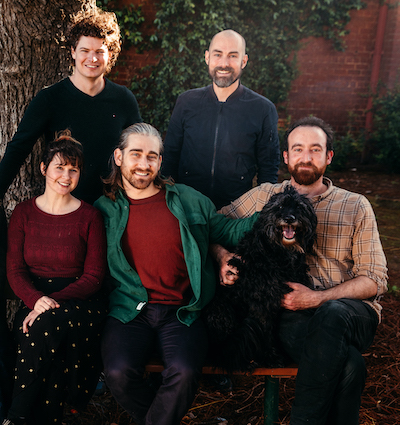What would happen if your pet dog was given the language and intelligence of a human being? That’s the premise of new play Bite the Hand, a dark comedy that asks discomforting questions about freedom.
What to SEE: Bite the Hand
4 October 2021
- Reading time • 10 minutesTheatre
More like this
- Just what the doctor ordered
- Lifting the weight of the world
- Gentle touch guides lunar landing
This article is sponsored content.
Premiering this October, Bite the Hand is the latest production from The Last Great Hunt, an award-winning, Perth-based collective of theatre makers who are always hunting for new ideas and ways of connecting with audiences.
Nina Levy spoke to playwright Chris Isaacs – also a core artist of The Last Great Hunt – to find out why you should check out his new work.
Nina Levy: Bite the Hand is a play about power. What made you decide to use the relationship between a pet and owner to explore this theme?

Chris Isaacs: I find when we talk about power relationships in society we can be pulled very quickly into the specifics of a particular power imbalance. I liked the idea of using the pet/owner relationship because it’s a more open analogy for a lot of relationships we have. There’s an asymmetry to the dynamic which most people in society take as a given. So essentially it gives me more freedom to explore the broader topics in the work.
NL: What was the starting point for Bite the Hand? How did it develop from that first concept into a script?
CI: I was commissioned to write a short play for five student actors at the Western Australian Academy of Performing Arts in (I think) 2016. That was a 20 minute piece which only looked at the central relationship of two owners and their dog. I wanted to give the actors something physical and fun to play, so animal work seemed a good option.
During the process I saw the potential in the ideas the short version touched on, so spent time imagining what the extended story might look like – how to grow the world, that sort of thing. I sat down to write the full-length version around 2017 and wrote some really crummy drafts. Luckily I work with good people at The Last Great Hunt, and they gave feedback, and I worked on it again and again, got Matt Edgerton involved as director, and over the last 18 months he and I have really put the script through the ringer.
It’s a long process writing a play. Long. (Breathes heavily)
NL: Most important question: How did you research the dog-related content for the play?
CI: Best research ever! I looked at dog vids. I looked at how the animals act. I watched docos on wolves. I spoke to a few dogs at the local park, but they said they’d prefer to remain anonymous.
I looked at dog vids. I looked at how the animals act. I watched docos on wolves. I spoke to a few dogs at the local park, but they said they’d prefer to remain anonymous.
Chris Isaacs on researching ‘Bite the Hand’
I also looked into the evolution of the human/dog symbiosis; that time when the wild dog ancestors began to work with humans for food and companionship, and how humans slowly developed breeding processes to create the domestic breeds we have today, an interesting and strange deep dive.
Then there was some reading and watching of dog training gurus like Caesar Milan, and research into different animal rights movements.
And yet, we never actually present a pure “dog” in the play. Because of the concept we’re showing this imagined version of a heightened consciousness dog – and a big part of the conversation in the rehearsal room at the moment is on what exactly are these animals? Where on the dog human spectrum do we place them?
It’s a really fun question the actors are constantly playing with.
NL: The Last Great Hunt presented an online version of Bite the Hand last year – which was promoted as a reading but in fact felt much more developed than that. How did that COVID-induced development influence the way this production has unfolded?

CI: That’s nice of you to say. It was really beneficial for Matt, the director, and me to see how the actors interpreted the text. It gave us time to start the initial conversations on relationships and the world’s rules before we rehearsed this year. It meant actors were sort of working with each other (in that lonely blue dot realm of Zoom) and creating a working vernacular.
I got to listen to the script a few times with great performers, and from that certainly identified where changes could be made (four drafts later here we are). Finally it’s allowed us as a collective of actors and designers to move quickly in rehearsing the work.
NL: You’ve been writing for the stage for some time now; Seesaw readers may recall your latest play York, co-written with Ian Michael, was premiered by Black Swan State Theatre Company earlier this year. When and how did you come to playwriting?
CI: I always liked live performance. I was studying Writing and English at university – there weren’t many units in “Writing” to complete the degree so you had to do pretty much all of them. I did a “Writing for performance” unit where our lecturer was a working playwright in Perth. I handed him a play I wrote in high school – this derivative Beckett rip off – he liked it and put me in touch with theatre makers and we did the play.
So I guess I’ve had it in me from a younger age, but it’s taken me a while to feel like I know what I’m doing when I write something… and even then… like… some of it is just luck… most of it is just luck.
Yeah I work hard and sure I get that… but really – there’s always that voice that lingers saying “you don’t have clue do you?” And between you and I, maybe I don’t.
NL: What is the most challenging aspect of writing a script?
CI: Taking all the feedback on drafts from many different voices, processing it, looking at what you’ve done, letting go of your ego and getting to work. That and trying to get a scene to end at the bottom of a page so you don’t have to print an extra page with just one line on it.
NL: And the most rewarding?
… the moment you have a communal response from audience; a laugh, a jump scare, a lean forward, an exhale…
Chris Isaacs reflecting on the most rewarding aspects of writing a script.
CI: The people you get to work with and the moment where you’re in an audience watching them find things in the play you never knew were there. And the moment you have a communal response from audience; a laugh, a jump scare, a lean forward, an exhale…
NL: What do you hope audiences will take away from Bite the Hand?
CI: Is it too simple to say I hope they enjoy it? I’d like them to engage with it, but really with where we are at in the world and everything it’s just nice to be able to have something that we can gather together for. It’s nice to be in a room with others and have a shared experience – and we’re really lucky we get to do that.
If nothing else I hope they feel that.
Bite the Hand plays Subiaco Arts Centre, 12-23 October 2021.
Pictured top: ‘Bite the Hand’ playwright Chris Isaacs and director Matthew Edgerton with dog Molly. Photo: Annie Harvey
Like what you're reading? Support Seesaw.






